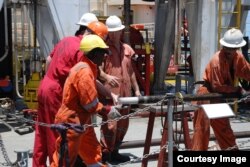Corals on the Great Barrier Reef adapted to greater temperature changes in the past than previously thought, a new study finds.
The reef is one of the world’s greatest natural wonders. Stretching some 2,300 kilometers along Australia's northeastern coastline, it is an intricate mosaic of corals, cays and topical islands. The sprawling ecosystem teems with marine life and is a sanctuary for sea birds.
The scientists involved in the study want to understand how the reef has responded to a sea level rise and temperature change since the peak of the last Ice Age, 20,000 years ago.
“The major aim of our expedition was to reconstruct sea level so you can use fossil corals to reconstruct sea level," said paleo-climatologist Thomas Felis, who analyzed the data at the University of Bremen's Center for Marine Environmental Sciences. "And the Great Barrier Reef is a quite stable region in terms of tectonics of the Earth’s crust. It is far away from continental glaciers so it gives a good global average of sea level variations.”
In 2010, the expedition crew set out aboard the Greatship Maya, equipped with a drilling rig that would extract coral fossils from the tropical Pacific Ocean.
Felis notes that the global sea level then was 120 meters lower than it is today.
“At that time all the ocean water was stored in the form of ice in the continental glaciers in the Northern hemisphere, Greenland and Antarctica,” he said.
But not in Australia, which was colder than it is now and unusually dry. Using surveys that identified reef like structures below the sea bed, Felis says remotely operated vehicles were sent down deep in the ocean to pinpoint exactly where to dig.
“We drilled down to 40 to 50 meters into the sediment, into the fossil structures and recovered corals," he said. "And once these corals were on deck we were able to identify corals and coral reef structures.”
The crew recovered coral material between February and April, and shipped it to the Bremen Coral Repository in Germany for analysis says Felis, lead author of the study which was reported in Nature Communications.
“One of our major findings is that the Great Barrier Reef, since the last Ice Age, experienced much larger temperature changes than previously thought," Felis said.
In addition, Felis says sea surface temperatures were two to three degrees Celsius cooler along the southern Great Barrier Reef compared to the northern site they studied. By contrast, he says, that difference today is 0.6 degrees Celsius.
“What we found [was] that these corals were quite happy," he said. "They adapted somehow to temperatures changes over a period of thousands of years. However, what we experience today is that we probably will have, in the next decades, temperature changes of the same magnitude. But it’s important to note that these are temperature changes that will happen within just 100 years and not thousands of years.”
Felis adds that the study does not infer that today’s Great Barrier Reef could be capable of easily adapting to a continued rise in ocean temperature. He says it does provide a framework for how the reef responded to past sea level rise and climate change to better understand future resilience.
The reef is one of the world’s greatest natural wonders. Stretching some 2,300 kilometers along Australia's northeastern coastline, it is an intricate mosaic of corals, cays and topical islands. The sprawling ecosystem teems with marine life and is a sanctuary for sea birds.
The scientists involved in the study want to understand how the reef has responded to a sea level rise and temperature change since the peak of the last Ice Age, 20,000 years ago.
“The major aim of our expedition was to reconstruct sea level so you can use fossil corals to reconstruct sea level," said paleo-climatologist Thomas Felis, who analyzed the data at the University of Bremen's Center for Marine Environmental Sciences. "And the Great Barrier Reef is a quite stable region in terms of tectonics of the Earth’s crust. It is far away from continental glaciers so it gives a good global average of sea level variations.”
In 2010, the expedition crew set out aboard the Greatship Maya, equipped with a drilling rig that would extract coral fossils from the tropical Pacific Ocean.
Felis notes that the global sea level then was 120 meters lower than it is today.
“At that time all the ocean water was stored in the form of ice in the continental glaciers in the Northern hemisphere, Greenland and Antarctica,” he said.
But not in Australia, which was colder than it is now and unusually dry. Using surveys that identified reef like structures below the sea bed, Felis says remotely operated vehicles were sent down deep in the ocean to pinpoint exactly where to dig.
“We drilled down to 40 to 50 meters into the sediment, into the fossil structures and recovered corals," he said. "And once these corals were on deck we were able to identify corals and coral reef structures.”
The crew recovered coral material between February and April, and shipped it to the Bremen Coral Repository in Germany for analysis says Felis, lead author of the study which was reported in Nature Communications.
“One of our major findings is that the Great Barrier Reef, since the last Ice Age, experienced much larger temperature changes than previously thought," Felis said.
In addition, Felis says sea surface temperatures were two to three degrees Celsius cooler along the southern Great Barrier Reef compared to the northern site they studied. By contrast, he says, that difference today is 0.6 degrees Celsius.
“What we found [was] that these corals were quite happy," he said. "They adapted somehow to temperatures changes over a period of thousands of years. However, what we experience today is that we probably will have, in the next decades, temperature changes of the same magnitude. But it’s important to note that these are temperature changes that will happen within just 100 years and not thousands of years.”
Felis adds that the study does not infer that today’s Great Barrier Reef could be capable of easily adapting to a continued rise in ocean temperature. He says it does provide a framework for how the reef responded to past sea level rise and climate change to better understand future resilience.










